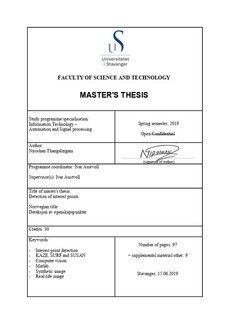| dc.contributor.advisor | Austvoll, Ivar | |
| dc.contributor.author | Thangalingam, Niroshan | |
| dc.date.accessioned | 2019-10-04T11:25:49Z | |
| dc.date.available | 2019-10-04T11:25:49Z | |
| dc.date.issued | 2019-06-14 | |
| dc.identifier.uri | http://hdl.handle.net/11250/2620317 | |
| dc.description | Master's thesis in Automation and signal processing | nb_NO |
| dc.description.abstract | This thesis reviews methods for interest point detectors to detect salient points that have an expressive structure such as corners or blob features. Properties of good interest point detectors are that interest points are being detected regardless of geometric or photometric changes such as scaling, rotation, noise, and brightness in the image.
Two of the more common interest point detectors are Speeded Up Robust Features (SURF) and Smallest Univalue Segment Assimilating Nucleus (SUSAN), both being essential milestones in feature detection and are still wildly used in various applications in fields like interest point detection. In contrast, research on KAZE algorithm has been scarce. However, interest in further research has been gaining traction within the community. This stands to the reason why the focus will be on how the KAZE detector will perform compared to SUSAN and SURF detectors. KAZE was selected as it is quite new compared to the others, and the fact that it uses nonlinear scale space compared to algorithms such as SURF that uses Gaussian scale space. Furthermore, three images were used for the experiments, where the first image is a synthetic image with different geometrical shapes. Second and third images are real-life images of a building and a boy, respectively.
The results of the synthetic image with different geometrical shapes show that the detectors have different results on each experiment carried out for this type of image. While for the real-life images, KAZE and SURF proved vastly superior compared to SUSAN. This led to the conclusion that the detectors should be selected according to the type of experiment carried out. Additionally, in terms of the detector speed, SURF was the fastest detector compared to the other detectors. | nb_NO |
| dc.language.iso | eng | nb_NO |
| dc.publisher | University of Stavanger, Norway | nb_NO |
| dc.relation.ispartofseries | Masteroppgave/UIS-TN-IDE/2019; | |
| dc.rights | Navngivelse 4.0 Internasjonal | * |
| dc.rights.uri | http://creativecommons.org/licenses/by/4.0/deed.no | * |
| dc.subject | informasjonsteknologi | nb_NO |
| dc.subject | automatisering | nb_NO |
| dc.subject | signalbehandling | nb_NO |
| dc.title | Detection of interest points | nb_NO |
| dc.type | Master thesis | nb_NO |
| dc.description.version | submittedVersion | nb_NO |
| dc.subject.nsi | VDP::Technology: 500::Information and communication technology: 550 | nb_NO |

